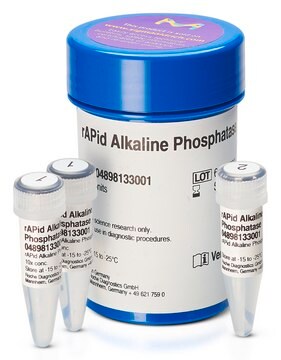API-RO
Roche
Alkaline Phosphatase (AP)
grade I, from calf intestine
Synonyme(s) :
AP, Alkaline Phosphatase
Se connecterpour consulter vos tarifs contractuels et ceux de votre entreprise/organisme
About This Item
Produits recommandés
Source biologique
bovine (calf) intestine
Niveau de qualité
Forme
suspension
Conditionnement
pkg of 1,500 U (10108138001)
pkg of 7,500 U (10108146001)
Fabricant/nom de marque
Roche
pH optimal
8.0-10.5
Absorption
7.6 at 278 nm (10 mg AP/ml)
Température de stockage
2-8°C
Description générale
At 37 °C with 4-nitrophenyl phosphate as the substrate, and diethanolamine as the buffer (400 U/mg at 25 °C with 4-nitrophenyl phosphate as the substrate, and glycine as the buffer)
Orthophosphoric-monoester phosphohydrolase (alkaline optimum)
Alkaline phosphatase catalyzes the removal of phosphate group from various compounds that are phosphorylated. It hydrolyzes 5′-monophosphate groups from both DNA and RNA. It can also hydrolyze 5′-diphosphate and 5′-triphosphate groups from RNA.
Alkaline phosphatase catalyzes the removal of phosphate group from various compounds that are phosphorylated. It hydrolyzes 5′-monophosphate groups from both DNA and RNA. It can also hydrolyze 5′-diphosphate and 5′-triphosphate groups from RNA.
Spécificité
Heat inactivation: AP activity is destroyed irreversibly by incubating the enzyme at 65 °C.
Denaturation is dependent on protein concentration - using less than 10 U/ml (0.1 mol/l glycine buffer, pH 10.5, 1 mmol/l MgCl2 and 0.1 mmol/l ZnCl2), AP is inactivated by a 10 minutes incubation at 65 °C.
Denaturation is dependent on protein concentration - using less than 10 U/ml (0.1 mol/l glycine buffer, pH 10.5, 1 mmol/l MgCl2 and 0.1 mmol/l ZnCl2), AP is inactivated by a 10 minutes incubation at 65 °C.
Application
Selective cleavage of terminal phosphate groups from oligonucleotides and in protein nucleotide exchange and deliverance. It has also been used to phosphorylate samples to distinguish between phosphate moieties present as phosphorylated glycans and phosphorylated amino acid residues.
Qualité
Contaminants: <0.0004% PDE, <0.004% ADA and A-5-MP deaminase, each
Séquence
AP is a dimer of identical or nearly identical subunits; each of which contains 2 molecules of Zn2+ , one tightly bound and necessary for structural stability, the other loosely bound and required for caytalytic activity. The active site contains a reactive serine.
In some mammals (e.g., humans), there are at least 3 distinguishable isoenzymes: the intestinal, the placental and the form found in bone/liver/kidney.
In some mammals (e.g., humans), there are at least 3 distinguishable isoenzymes: the intestinal, the placental and the form found in bone/liver/kidney.
Définition de l'unité
Unit Conversion: 1 Roche unit (tested at +25 °C) corresponds to ~2 to 2.5 Sigma units (tested at +37 °C).
AP activity is not expressed in Armstrong units; a conversion factor for international units is not known.
Approx. 3.8 U (grade I AP) or 4.0 U (grade II AP) [+37 °C, 4-NPP as substrate, diethanolamine as buffer, pH 9.8] = 1 U [+25 °C, 4-NPP as substrate, glycine as buffer, pH 10.5].
Biochemica Information. 87 (grade I AP) :
1.0 U [+37 °C, QC assay conditions] = 0.79 U [+30 °C, QC assay conditions] = 0.57 U [+25 °C, QC assay conditions]
AP activity is not expressed in Armstrong units; a conversion factor for international units is not known.
Approx. 3.8 U (grade I AP) or 4.0 U (grade II AP) [+37 °C, 4-NPP as substrate, diethanolamine as buffer, pH 9.8] = 1 U [+25 °C, 4-NPP as substrate, glycine as buffer, pH 10.5].
Biochemica Information. 87 (grade I AP) :
1.0 U [+37 °C, QC assay conditions] = 0.79 U [+30 °C, QC assay conditions] = 0.57 U [+25 °C, QC assay conditions]
Forme physique
Suspension in 3.2 M ammonium sulfate solution, 1 mM MgCl2, 0.1 mM ZnCl2, pH approximately 7
Notes préparatoires
- Activator: Divalent metal ions (Mg2+, Co2+, Mn2+)
- Amino alcohols (2-amino-2-methyl-1-propanol, diethanolamine)
Note that high concentrations of amino alcohols can as well act as competitive inhibitors (e.g., monoethanolamine in diethanolamine).
Storage conditions (working solution): The suspension is offered at a c= approx. 5 mg/ml.
If this suspension is diluted only 5 to 10-fold with further 3.2 M ammonium sulfate solution, 1 mM MgCl2, 0.1 mM ZnCl2, pH approx. 7, we would expect from general experience that a stability for some weeks might be given provided it is stored at 4 °C (no guarantee!).
Autres remarques
For life science research only. Not for use in diagnostic procedures.
Code de la classe de stockage
12 - Non Combustible Liquids
Classe de danger pour l'eau (WGK)
WGK 1
Point d'éclair (°F)
does not flash
Point d'éclair (°C)
does not flash
Faites votre choix parmi les versions les plus récentes :
Déjà en possession de ce produit ?
Retrouvez la documentation relative aux produits que vous avez récemment achetés dans la Bibliothèque de documents.
Les clients ont également consulté
METHOD SUMMARY
Stephanie Ketcham
Biotechniques, 117-123 (2017)
Brian M Zeglis et al.
Nature protocols, 2(2), 357-371 (2007-04-05)
This protocol describes the syntheses and applications of two metallointercalators, Rh(bpy)2(chrysi)3+ and Rh(bpy)2(phzi)3+, that target single base mismatches in DNA. The complexes bind mismatched DNA sites specifically and, upon photoactivation, promote strand scission neighboring the mismatch. Owing to their high
Raphael Gasper et al.
Small GTPases, 1(3), 133-141 (2011-06-21)
The Ras family is the largest and most diverse sub-group of Ras-like G proteins. This complexity is further increased by the high number of regulatory Guanine nucleotide Exchange Factors (GEFs) and GTPase Activating Proteins (GAPs) that target specific members of
O Brenna et al.
The Biochemical journal, 151(2), 291-296 (1975-11-01)
A crude preparation of alkaline phosphatase (EC 3.1.3.1) from calf intestinal mucosa was purified by affinity chromatography on Sepharose-bound derivatives of arsanilic acid, which was found to be a competitive inhibitor of the enzyme. Three biospecific adsorbents were prepared for
Protocoles
Alkaline Phosphatase (AP) Protocol
Notre équipe de scientifiques dispose d'une expérience dans tous les secteurs de la recherche, notamment en sciences de la vie, science des matériaux, synthèse chimique, chromatographie, analyse et dans de nombreux autres domaines..
Contacter notre Service technique





